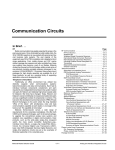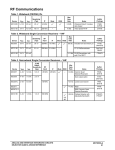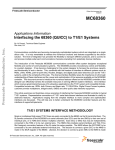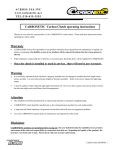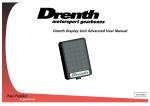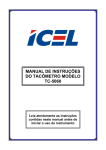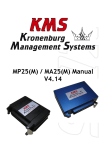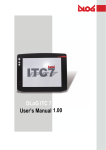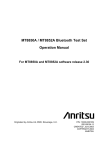Download m mc145540 adpcm codec evaluation kit
Transcript
Freescale Semiconductor, Inc. MOTOROLA SEMICONDUCTOR SECTION 1 TECHNICAL DATA GENERAL DESCRIPTION 1.1 ORGANIZATION OF DATA SHEET Advance Information This document is composed of 4 sections. Section 1 is intended to introduce the MC145537EVK ADPCM Codec Evaluation Kit with a brief description of the evaluation board and a list of key features. Section 2 introduces the hardware comprising each functional block of the MC145537EVK and the computer terminal interface. Section 3 describes the stand alone hardware operating mode and indicates a recommended jumper positioning for this mode. It also discusses the back-to-back full duplex modes of operation using two MC145537EVKs or one MC145537EVK with one MC145536EVK. Section 4 describes the software interface for the computer terminal and the subroutine commands available via the on-board MC68HC705C8P microcontroller. Freescale Semiconductor, Inc... MC145540 ADPCM C EVALUATION KIT +5V GN NOTE This User's Manual - MC145537EVK ADPCM Codec Evaluation Kit, corresponds with MC145537EVK Printed PIEZO Circuit Board REVISION C (XMOJOX1X92X). SPEAKER CLOCK GENE CIRCUIT 1.2 INTRODUCTION 5V/3V The MC145537EVK is the primary tool for evaluation and demonstration of the LEVEL SHIFT MC145540 ADPCM Codec. The MC145537EVK provides the user with the necessary hardware and software interface needed to access the many features and operational modes of the MC145540 ADPCM Codec. Figure 1-1 on the following page is a functional block diagram of the MC145537EVK. The MC145537EVK is comprised of the MC145540 ADPCM Codec which can operate MC145540 Analog from 2.7 to 5.25 volts, the 5 volt circuitry that includes the clock generation circuitry, ADPCM CODECthe Interface MC68HC705C8P microcontroller and the MC145407 EIA232 interface, and the logic level shifters which interface the ADPCM Codec to the clock generator and microcontroller. 3V/5 SCP LEVEL S 5V/3 User I/O to the board is provided via a number of convenient connectors. There are five analog interfaces for the device: an industry standard 4-pin RJ-11 handset jack (P3) is provided to connect the included handset, the BNC connector (P2) for the line level transmit analog input, the BNC connector (P4) for the line level receive analog output, the wire clamp connector (P5) for access to the auxiliary output, and the Piezo loud This document contains information on a new product. Specifications an speaker which is jumper selectable to be driven by the auxiliary output. There are three digital interfaces including the DB25 connector (P6) for the serial EIA232 interface for the computer terminal, a 2x20 pin header (P9) for access to the ADPCM serial data and MC145537EVK MOTOROLA © MOTOROLA INC., 1992 1-1 For More Information On This Product, Go to: www.freescale.com Freescale Semiconductor, Inc. Freescale Semiconductor, Inc... Paragraph Number TABLE OF C Tit 1.1 1.2 1.3 SECT GENERAL DE Organization Of Data Sheet.................. Introduction.............................................. Features................................................... 2.1 2.2 2.3 2.4 2.5 2.6 2.7 2.8 SECT HARDWARE D Power Supply Configurations ............... Clock Generation Circuitry.................... MC145540 ADPCM Codec................... MC68HC705C8P.................................... MC145407 and EIA232 Port Descripti Computer Terminal Interface Descript Jumper Descriptions .............................. Handset.................................................... 3.1 3.2 3.3 SECT OPERATING CO MC145537EVK Single Board Analog MC145537EVK to MC145537EVK Fu MC145537EVK to MC145536EVK Fu 4.1 SECT MICROCONTROLLER SOF Computer Terminal Software Comma Figure 1-1. LIST OF ILLU MC145537EVK Functional Block Figure 2-1. DSW1 Settings for Transcoding Motorola reserves the right to make changes without further notice to any products Figure 2-2. Jumper Positions herein to improve reliability, function, or design. Motorola does not assume any liabilityfor Switching T EIA-232 Serial Computer Termin arising out of the application or use of any product or circuit described herein; neither Figure 3-1. Jumper Settings for Digital Loopb does it convey any license under its patent rights nor the rights of others. Motorola Figure 3-2. devices Recommended Configuration for products are not authorized for use as components in life support of systems Operation ........................................ intended for surgical implant into the body or intended to support or sustain life. Buyer Figure 3-3. Recommended Configuration for agrees to notify Motorola of any such intended end use whereupon Motorola shall Operation ........................................ determine availability and suitability of its product or products for the use intended. Figure 4-1. Input Modes of the MC1 Motorola and µ are registered trademarks of Motorola, Inc. Motorola, Inc./ Output is an Equal Employment Opportunity/Affirmative Action Employer MC145537EVK MOTOROLA MOTOROLA ii i For More Information On This Product, Go to: www.freescale.com Freescale Semiconductor, Inc. the controlling clocks, and a 2x16 header SECTION 2 signals. HARDWARE DESCRIPTION The MC145537EVK is powered by the three at the top of the circuit board. This evaluatio clock generator, microcontroller and EIA232 NOTE be powered by this 5 volt supply as selected Please refer to the MC145537EVK Schematic for discussion 2.7 volts to 5.25 volts that is also applied at P of the hardware. Freescale Semiconductor, Inc... 2.1 POWER SUPPLY CONFIGURATIONS +5V The MC145537EVK is powered by the three terminal wire clamp connector, P7 located at the top of the circuit board. This evaluation board requires a +5V supply to power the clock generator, microcontroller and EIA232 port. The MC145540 ADPCM Codec may be powered by this 5 volt supply as selected by jumper J2 or by an additional supply of PIEZO 2.7 volts to 5.25 volts that is applied at the third terminal of P7. SPEAKER The MC145540 powers-up from a hardware reset (S3) in a mode with the on-chip charge pump running. This allows the device to operate with a power supply as low as 2.7 volts to as high as 5.25 volts. For 5 volt operation, jumper J2 should be left in the 5V position. This selects the 5 volt power supply terminal of P7 to be connected to the VEXT pin of the MC145540. The charge pump may be turned off or left running. 5V/3V CLOCK G CIRC LEVEL SHIFT For lower voltage applications (i.e. 3 volts), jumper J2 should be moved to the 3V position, and jumper J1 should be in the position marked 3EXT. This jumper configuration connects the MC145540 VEXT pin and the logic level shifting circuitry to the third terminal of P7 so that the MC145540 may be powered from an off-board lower voltage power supply. Analog MC145540 Jumper J12 allows the MC145540 to be connected to eitherInterface of the 5 volt supply ADPCM(VCC), CODEC or the lower voltage supply (VDD). This jumper should be left in the VDD position except to insert an ammeter for measuring the current of the MC145540 only. S LEV Jumper J13 connects the MC145540 VDD pin (VDDA) to the VEXT pin for 5 volt applications with the charge pump turned off. Figure 1-1. MC145537EVK 2.2 CLOCK GENERATION CIRCUITRY A 20.48 MHz crystal oscillator is used as the System Clock for the MC145537EVK. From this 20.48 MHz crystal, Frame Sync (FSYNC), Bit Clock (BCLK), and Signal Processor Clock (SPC) are derived for use by the MC145540. MC145537EVK MOTOROLA MOTOROLA 1-2 2-1 For More Information On This Product, Go to: www.freescale.com Freescale Semiconductor, Inc. MC145540 Features (cont.) 1.3 FEATURES • Low Noise, High Gain, Three T Interface • Push-Pull 300Ω Power Drivers Interface Freescale Semiconductor, Inc... GENERAL • Provides Stand Alone Evaluation on Single Board • The kit provides analog to analog, analog to digital• (64 kbps PCM, 300Ω Auxiliary Outpu Push-Pull 32 kbps ADPCM, 24 kbps ADPCM, CCITT G.726 16 kbps ADPCM and Motorola proprietary 16 kbps ADPCM), or digital (64 PCM, Regulated 32 kbps Charge Pum • kbps Voltage ADPCM, 24 kbps ADPCM, CCITT G.726 16 kbps ADPCM and Motorola Voltage Applications proprietary 16 kbps ADPCM) to analog connections. • Receive Side Noise Burst Dete +5 Volt Only Power Supply or 5 Volts Plus 2.7 to 5.25 Volt Supply. • Custom DSP Engine Optimized Easily Interfaced to Test Equipment, Customer System, Second MC145537EVK or MC145536EVK (for 5 volt operation only) for Full Duplex Operation. • • • Convenient Access to Key Signals • Piezo Loud Speaker • EIA232 Serial Computer Terminal Interface for Control of the MC145540 ADPCM Codec Features. • Compatible Handset Provided • Schematics, Data Sheets, and User's Manual Included MC145540 Features • Single 2.7 to 5.25 Volt Power Supply • Typical 3 Volt Power Dissipation of 65 mW, Power Down of 0.1 mW • Differential Analog Circuit Design for Lowest Noise • Complete Mu-Law and A-Law Companding PCM Codec/Filter • Conforms to CCITT and ANSI Standards for ADPCM Transcoding at 64, 32, 24 and 16 kbps data rates • Universal Programmable Dual Tone Generator • Programmable Transmit Gain, Receive Gain and Sidetone Gain MC145537EVK MOTOROLA MOTOROLA 1-4 1-3 For More Information On This Product, Go to: www.freescale.com Freescale Semiconductor, Inc. 2.4 MC68HC705C8P FSYNC - Frame Synchronization Pulse DSW1 allows thethat userare to select the "width The MC145537EVK is designed to accommodate additional features not cycles. The the individual switches currently supported by the resident software. Three examples include two LEDs (D6 of DSW1 resistors areaccess connected and D7), the push button switch (S1) and the 2x16 header (P8). P8that gives to theto the inputs o of parallel DSW1 is loaded into the shift r MC145540 reset pin, the MCU reset pin, SCP control portThe and value an 8-bit port. BCLK signal. The inputs of this shift r microcontroller using the FW (Frame sync section 3 for the software command set. NO be in the open position and that the microc open to this node for the clock circuit to oper Figure 2-1 below indicates the proper dip sw and 16 kbps long frame clocking, and 32 kb For 64 kbps operation, switches 1, 2 and 3 output of the shift register has only one ris load / shift cycle. Refer to the MC145540 Da 64kbps 32kbps 24k DSW1 ---> DSW1 ---> DS -1 2 ON 1 2 ON 1 2 3 4 5 6 7 8 8 8 7 7 6 6 4 5 4 5 3 3 Freescale Semiconductor, Inc... Sync (FSYNC) thea 8 kHz signa The MC68HC705C8P is one of Motorola's popular 8-bitFrame microcontrollers which ishas (PCM) words. The ADPCMThe transcoding rate Serial Peripheral Interface port (SPI) and an asynchronous interface. controlled bySerial the width of the MC145537EVK utilizes the SPI port for interface to the MC145540's Control Portframe sync me pins9600 respectively. and FSR signals (SCP). The asynchronous interface is used for the EIA-232 bps serialThe portFST for the ADPCM Codec routine to determine computer terminal interface. The microcontroller executes a monitor which the sample r analog conversions. FSYNC is presented to supports sixteen commands for programming and monitoring the status of the the MC145540 for FSR pin and FST pin resp MC145540 ADPCM Codec. The position of this switch is Open / Off. Figure 2-1. DSW1 Setting MC145537EVK MOTOROLA MOTOROLA 2-2 2-5 For More Information On This Product, Go to: www.freescale.com Freescale Semiconductor, Inc. 2.3 MC145540 ADPCM CODEC Freescale Semiconductor, Inc... BCLK - ADPCM/PCM Data Bit Clock The MC145540 ADPCM Codec is a single Bit Clock (BCLK) is the Clock that controls the ADPCM/PCM bit ADPCM transfers.encoder/decoder The BCLK and an and th signal is presented to J6-B and J6-C for selected use by the MC145540 ADPCM Codec applications requiring the digitization and for bit clock receive (BCLKR) and for bit clock transmit (BCLKT) devicerespectively. is designed to operate over a wide vo is ideal for battery powered as well as A P1 allows the user to select the frequency of BCLK. The ADPCM jumper selectable frequencies Codec also includes a serial co are 2.048 MHz, 1.024 MHz, 512 kHz, 256 kHz, 128 kHz,registers and 64 kHz. It is important to that permit a microcomputer to exe note that only one frequency should be selected at any time. The duration of the FSYNC signal is controlled by the BCLK clock cycles, but theADPCM frequency of FSYNC is The Codec is designed to me always 8 kHz when either of the BCLK frequencies is selected. requirements of CCITT Recommendation G T1.303 and CCITT Recommendation G.72 256kHz 16 kbps ADPCM standard, CCITT Recomme PCM conformance specification of the CCITT 256 kHz is presented to J6-A for connection to BCLKR for use as the internal sequencing clock for the codec-filter and charge pumpPlease functions of to thethe device. The data sheet f refer included option for using BCLKR as the source for the internal 256 kHz sequencing clock must ADPCM Codec. be programed via the SCP port at byte register zero, bit 7. SPC - Signal Processing Clock SPC is a 20.48 MHz clock signal presented to the MC145540 signal processor clock (SPC, 21) pin for use as its digital signal processor clock. There are several options for the SPC which are controlled by jumpers J17, J8 and J18. It is important to note that J8 should not be selected when J18 is selected, only one of these jumpers should be on the evaluation board at the same time. J17 selects the on-board 20.48 MHz clock to drive the SPC pin of the MC145540. J8 selects a buffered 20.48 MHz to be output to the P9 header. This allows the on-board oscillator to be used off of the board. J18 connects the SPC pin of the MC145540 to the P9 header pins to allow an external SPC clock to drive the MC145540. If an off-board clock is used for SPC, then both J17 and J8 should be removed from the board. To use two MC145537EVK boards together for full duplex audio, J17 is used and J8 and J18 are removed from the boards. This configuration is also good for use with an MC145536EVK which has the MC145480 5 volt PCM Codec-Filter and MC145532 ADPCM Transcoder. When two MC145537EVK boards are connected together with a ribbon cable that is about 2 inches (about 5 centimeters), one 20.48 MHz clock may be used for both evaluation boards. The jumpers will not be the same for both boards. The 20.48 MHz clock may feed-through to the other board via the ground circuit and cause noise, which may be eliminated by externally connecting a wire to one side of R3 of one board to the other side of R3 of the other board. MC145537EVK MOTOROLA MOTOROLA 2-4 2-3 For More Information On This Product, Go to: www.freescale.com Freescale Semiconductor, Inc. J10 J11 J12 J14 J15A,B J16 J18 Connects the SPC pin of the MC145540 to the 40 pin header connecter, P9. This jumper must be removed if jumper J8 is connected. C31 Connects the level shifted 3 volt 20.48 MHz on-board oscillator to the MC145540 SPC pin and to the buffers for off-board use. This jumper must be removed if the SPC pin is to be driven by an external clock. P6 C30 J17 C33 C35 C34 C32 MC145407 Freescale Semiconductor, Inc... J13 Invert TX and RX circuits to / from EIA-232 connecter 2.5 MC145407 (P6) for and proper EIA232 PORT DESCRIP operation The MC145407 is a single 5 volt power sup Forces the microcontroller into a continuous receivers reset state. in addition to an on-chip voltage develops the drive voltages to satisfy the E Connects the VEXT pin of the MC145540 to the the level powershifting supply and signal conditioning to independent of the level shifters and MC145540 resetanpull-up resistor. produce EIA-232 serial This port which operat accommodates current measurements for the MC145540. This jumper controlled by the microcontroller's crystal. should usually be connected to the VDD position. MC145540 configuration and control da Connects the MC145540 pin VDD to its power supply pin VEXT. is MC145537EVK via aThis computer terminal. An used only when the MC145540 is used at 5 volts and the on-chip charge connector (board side) and the appropriate pump must be disabled by programming theserial MC145540 at byte registeris the 3 wire minim computer interface zero, bit 2. data, receive data and signal ground. Only connected. Upon turning on the board, or p Connects either RO or PO- as analog outputmessage from MC145540 to the BNC should appear on the screen: connecter P4 Motorola MC145537EVK Evaluation KI J15A connects the AXO- signal to wire clamp connector P5. J15B MC145540> connects the AXO- signal to the piezo speaker SP1. Where X.X represents the software revision This jumper is a control input to the microcontroller. It is intended to tell the microcontroller that two MC145537EVK boards are connected together at If the computer terminal is configured correc the 32 pin header connecter P8 so that one microcontroller control the MCU reset may switch is released, then the t both MC145540 ADPCM Codecs, thus eliminating the need for more than the DB-25 connecter) may need to be exch one computer terminal. This option is not presently supported thejumpers J10-A, J10-B This may be donebyby microcontroller software. The user may use this a control input for options. two as jumper configuration software development. --> J10ABCD MCU RESET R 1 7 C 2 6 C10 Figure 2-2. Jumper Positions for Switch EIA-232 Serial Compu MC145537EVK MOTOROLA MOTOROLA 2-6 2-9 For More Information On This Product, Go to: www.freescale.com Freescale Semiconductor, Inc. 2.6 COMPUTER TERMINAL INTERFACE DESCRIPTION2.7 JUMPER DESCRIPTIONS The serial computer terminal interface uses only transmitThe data, following receive table data and shows signal all on-board jum ground. These signals are on circuits 2, 3 and 7 of the DB-25. Please See reference the section the schematic on the for additiona MC145407 and EIA-232 port for reconfiguring the circuits for pin 2 and pin 3. The Jumper Functionality computer terminal should be configured for: 1. 9600 bps (bits per second or 9600 baud) J1 If VDD is selected for 3 volts by +3 volt power supply input of P from the 5 volt supply. J2 Sets VDD power supply of the power supply wire clamp conne for the logic level shifters and t J3 Connects the on-board 20.48 M generate the 8 kHz FST, bit clo allows these clocks to be deriv J4 Connects the on-board 20.48 M logic level shifter for driving the MC145540. This jumper allows oscillator to clock the SPC pin J5A,B Connects the 8 kHz FSYNC on respectively of the MC145540. J6A,B,C J6A connects the on-board 256 MC145540 for use as the intern pin as the input for an external be selected by programming th and J6C connect the on-board J7A,B Connects the on-board 256 kH 40 pin header connecter, P9. T PCM Codec-Filter on an MC14 MCLK function is similar to the of the MC145540. J8 Connects a buffered on-board pin header connecter, P9 for of connected if Jumper J18 is con SPC pins of P9. J9 Connects the ADPCM / PCM o ADPCM / PCM input (DR pin) operation. 2. Full-duplex Freescale Semiconductor, Inc... 3. 8-Bit data words 4. 1 stop bit 5. Parity should be turned off 6. Linefeed automatic with return MC145537EVK MOTOROLA MOTOROLA 2-8 2-7 For More Information On This Product, Go to: www.freescale.com Freescale Semiconductor, Inc. 3.2 MC145537EVK to MC145537EVK Full-Duplex Analog 2.8 HANDSET End-to-End Freescale Semiconductor, Inc... The compatible handset included with th The MC145537EVK evaluation boards were designed to connect back-to-back. A 2x20 W3-K-EM-80, reverse polarity. The hands header connecter with a ribbon cable, 36 inches (about one meter) maximum in length, The handset incorporates a low makes the necessary electrical connections allowing a fullconnector. "analog-to-analog", "handsetequipped a hearing aid coil and to-handset" path to be established. The three volt supply isreceiver not connected to with the ribbon cable and therefore the MC145537EVK should be operated at 5 volts for logic level TRANSMITTER compatibility with maximum digital noise immunity between the two MC145540 ADPCM Codecs. Transmit Output Level @ 1000 Hz: -46 dBV Output Impedance @ 100 Hz: 1000 ± 300Ω NOTE Power (5 volt) and Ground are bussed from one RECEIVER MC145537EVK to the second MC145537EVK. Do not connect a second power supply to the second Receive Output Level @ 1000 Hz: 79 dBSPL MC145537EVK! Receive Input Impedance @ 100 Hz: 150 Ω For more detailed characteristics of the W3 Equipment Corporation in North America at 1 MC145537EVK MOTOROLA MOTOROLA 2-10 3-3 For More Information On This Product, Go to: www.freescale.com Freescale Semiconductor, Inc. C10 J11 C8 C7 C6 J4 J3 C3 U3 CLK GEN C5 5V 3V J2 VDD C1 DSW1 RP1 ---> U1 D2 C2 U2 +5V GND +3V D4 3EXT 3REG J1 C11 AXO>P5 AXO>SP J15AB R26 P2 (enables digital loopback) (EIA-232 cable dependent, swaps Tx and Rx pins to DB-25 connector) P5 PIEZO SPEAKER OUT C9 MCU RES VDD VDDA RO AXO>P5 AXO>SP1 BACK TO BACK SPC CLK SPC OFF 2048 RN1 R D 1 1 J11 J12 J13 J14 J15A J15B J16 J17 J18 P1 MC74HC393 REVISION-C XMOJOX1X92X IN IN IN IN OUT IN IN OUT OUT OUT IN MC145537EVK CLK GEN SPC FSYNC>FSR FSYNC>FST 256k>BCLKR BCLK>BLKCR BCLK>BCLKT BCLK>MCLK 256k>MCLK SPC>P6 DT>DR TOP ROW MC74HC390N UT J3 J4 J5A J5B J6A J6B J6C J7A J7B J8 J9 J10 MC145537EVK Notes (dependent on +3V source) (dependent on desired MC145540 supply voltage) 048 024 512 256 128 64 Position 3EXT 5V SPC MC74HC165N The following table shows all on-board jumpers and their corresponding positions for MC74HCU04 digital loopback which accommodates analog end-to-end operation. Jumper J1 J2 R C 2 6 R R 3 2 0 9 C12 D DR 3 5 2 U4 R4 R3 S2 J10ABCD C13 MC145537EVK SINGLE BOARD ANALOG END-TO-END OPERATION C4 C30 C32 20.48 MHZ R R 2 2 --> 8 7 C34 Y1 MCU RESET C31 C33 Freescale Semiconductor, Inc... R 1 7 C35 The following information describes the "most common" configurations that the MC145537EVK may operate. There are many configurations of operation that have not MC145407 been described in this document that the user may find useful. Please familiarize yourself with the included schematic diagram as this may provide insight into a configuration that may prove beneficial for evaluating these parts in your application. If there are specific questions on a particular configuration that is not documented, do not hesitate to contact your local Motorola Representative, or call the factory for assistance. 3.1 P8 P6 P9 SECTION 3 OPERATING CONFIGURATIONS OUT OUT IN OUT IN OUT Figure 3-1. Jumper Settings for Digital L MOTOROLA MOTOROLA 3-2 3-1 For More Information On This Product, Go to: www.freescale.com Freescale Semiconductor, Inc. MC145537EVK to MC145536EVK Full-Duplex Analog End-to-End MC145537EVK Board #1 Freescale Semiconductor, Inc... 3.3 The MC145536EVK and MC145537EVK evaluation boards were designed to connect back-to-back. A 2x20 header connecter with a ribbon cable, 2-3 inches maximum in length, makes the necessary electrical connections allowing a full "analog-to-analog", "handset-to-handset" path to be established. The 20.48 MHz oscillators may cause noise in the grounds between these boards resulting in a beat frequency tone in the audio channel. To eliminate this noise, use a jumper clip wire to connect one terminal of the crystal on the MC145537EVK to one terminal of the crystal on the MC145536EVK. This will synchronize the two crystals and eliminate the beat component. This noise is not present when a 36 inch (about one meter) ribbon cable is used and the on-board 20.48 MHz oscillator is used for the SPC on the MC145536EVK. The MC145537EVK must be operated at 5 volts for logic level compatibility between the MC145540 ADPCM Codec and the MC145532 ADPCM Transcoder. NOTE Power and Ground are bussed from the MC145537EVK to the MC145536EVK. Do not connect a second power supply to the MC145536EVK! Figure 3-2. Recommended Cabling Oper MC145537EVK MOTOROLA MOTOROLA 3-4 3-7 For More Information On This Product, Go to: www.freescale.com Freescale Semiconductor, Inc... Freescale Semiconductor, Inc. The following table shows all on-board jumpers and their corresponding positions for connecting one MC145537EVK to a second MC145537EVK full-duplexfor analog Jumper for Configuration second (clock rece operation. Jumper Position Jumper Configuration for first (clock generator) MC145537EVK. J1 3EXT J2 5V J3 CLK IN Jumper Position Notes J4 SPC IN J1 3EXT Not applicable J5 FSYNC>FSR OUT J2 5V 5 volt operation recommended FSYNC>FST OUT J3 CLK IN J6 256>BCLKR OUT J4 SPC IN BCLK>BLKCR OUT J5 FSYNC>FSR IN BCLK>BCLKT OUT FSYNC>FST IN J7 BCLK>MCLK OUT J6 256>BCLKR OUT 256>MCLK OUT BCLK>BLKCR IN J8 SPC>P6 OUT BCLK>BCLKT IN J9 DT>DR OUT J7 BCLK>MCLK OUT J10 TOP ROW 256>MCLK OUT J8 SPC>P6 OUT J11 MCU RES OUT J9 DT>DR OUT J12 dependent, VDDswaps Tx J10 TOP ROW (EIA-232 cable J13 VDDA OUT and Rx pins to DB-25 connector) J14 RO J11 MCU RES OUT J15 AXO>P5 OUT J12 VDD AXO>SP1 IN J13 VDDA OUT J16 BACK TO BACK OUT J14 RO J17 SPC CLK IN J15 AXO>P5 OUT J18 SPC OFF OUT AXO>SP1 IN P1 2048 J16 BACK TO BACK OUT J17 SPC CLK IN J18 SPC OFF OUT P1 2048 MC145537EVK MOTOROLA MOTOROLA 3-6 3-5 For More Information On This Product, Go to: www.freescale.com Freescale Semiconductor, Inc. Freescale Semiconductor, Inc... 4.1 COMPUTER TERMINAL SOFTWARE COMMAND SET MC145536EVK Board #2 SECTION 4 MICROCONTROLLER SOFTWARE COMMAND SET The following is a list of all commands currently available, along with an explanation on their function. In all cases, an error in the command entry will be signalled by the message on the CRT: Error: unknown command. In addition, if the number of parameters specified is less than what the command requires, the message Error: parameter(s) input will be displayed on the computer terminal display. The monitor routine expects all numbers and coefficients to be in hexadecimal form. HE (Help command) Print out the command menu. RE <logic state> (Reset command) Force the reset line to the MC145540 to whichever state has been specified by logic state. Recall that the reset line into the MC145540 is an active low line, i.e., the part is held in the reset state when the logic state is specified as zero. For a valid reset and reactivate cycle to occur,this command must be executed twice. Once for setting the reset pin low (RE 0), followed by a command to take the reset pin high again (RE FF) This is an alternative to the reset pushbutton switch, S3. DR (Display all SCP registers) Read all 10 SCP registers (plus silicon mask register BR15) and display their contents on the computer terminal display. SC [register address] <scp data> (SCP access command) Execute an access to SCP register specified by register address. If scp data is included, it is written to the register; otherwise, the access is to read the register. In either case, the contents of the register after the access is completed are displayed at the computer terminal display. This command allows full manipulation of the control registers. To display the status of byte register 2, (SC 2). To turn on the AXO+ and AXO- driver pair, (SC 2 40). This command will also program the dc bias voltage for the RO, PO-, PO+, PO-, AXO+ and AXO- outputs to half of the VEXT voltage. This command will always program all of the accessed byte register's functions. SS [register address] <scp data> (SCP access command) Same as the SC command explained above, except it continuously accesses the SCP interface, whether for read or write. This is useful in debugging situations, in which it is necessary to synchronize some test equipment with an access the Recommended SCP interface. Configuratio Figureon3-3. This successive read is terminated when the Tone Demo switch, S1 or the Oper microcontroller reset switch, S2 is depressed. MC145537EVK MOTOROLA MOTOROLA 3-8 4-1 For More Information On This Product, Go to: www.freescale.com Freescale Semiconductor, Inc... Freescale Semiconductor, Inc. The following table shows all on-board jumpers and their corresponding MC145536EVKpositions Jumper for Configuration connecting an MC145537EVK to an MC145536EVK for full-duplex operation. Jumper Position MC145537EVK Jumper Configuration J1 OUT J2A OUT J2B IN Jumper Position Notes J3A OUT J1 3EXT Not applicable J3B only IN J2 5V 5 volt operation *J4 OUT J3 CLK IN J5 OUT J4 SPC IN J6 OUT J5 FSYNC>FSR IN J7 IN FSYNC>FST IN J8 IN J6 256>BCLKR OUT *J9 OUT BCLK>BLKCR IN *J10 OUT BCLK>BCLKT IN J11A IN J7 BCLK>MCLK OUT J11B OUT 256>MCLK OUT J12A IN J8 SPC>P6 OUT J12B OUT J9 DT>DR OUT J13A dependent, IN swaps Tx J10 TOP ROW (EIA-232 cable J13B OUT and Rx pins to DB-25 connector) J14A OUT J11 MCU RES OUT J14B IN J12 VDD J15A IN J13 VDDA OUT J15B OUT J14 RO J16 IN J15 AXO>P5 OUT J17 IN AXO>SP1 IN J18 IN J16 BACK TO BACK OUT J19 IN J17 SPC CLK IN J20 OUT J18 SPC OFF OUT P1 2048 P1 2048 S1 ALL SWITCHES OPEN / CLOC MC145537EVK MOTOROLA MOTOROLA 3-10 3-9 For More Information On This Product, Go to: www.freescale.com Freescale Semiconductor, Inc. Freescale Semiconductor, Inc... ME [memory address] <memory data> (Mem Access the memory location specified by m microcontroller operates in internal memor goes from 0 to HEX 1FFF. If the address sp and a memory data field has been includ location, otherwise the memory location is re memory location after the access has been c TG [coefficient] [attenuation] [tone generator Program the tone generation function of the field, with the coefficient and attenuation i debugging aide, all SCP accesses required displayed on the screen. e.g. TG 100 200 generator to a frequency of 697 hertz at an amplitude would be (TG 6D5 200 1). Th sequence of SC commands: SC 7 'REM Read BR7 (SC 7) OR HEX 08 'REM Logical OR 'REM Let BR7=H SC 7 08 'REM Write HEX SC 4 D5 'REM Write lower SC 5 06 'REM Write to ton 'REM write the m 'REM coefficient i SC 7 'REM Read BR7. Is (SC 7) < HEX 80 'REM Check that 'REM read BR4 a SC 4 00 'REM Write the le 'REM coefficient i SC 5 42 'REM Write to ton 'REM write the m 'REM coefficient i SC 7 'REM Read BR7. Is (SC 7) < HEX 80 'REM Check that 'REM read BR4 a SC 7 0A 'REM Turn on ton MA <encoding mode> (Encoding law comma If an encoding mode field is specified, set th or A-law encoding (encoding mode = 1). O used. E2 [256 kHz clock option] (External 256 kHz Literature Distribution Centers: Set or reset the external 256 kHz clock op USA: Motorola Literature Distribution; P.O. Box 20912; Phoenix, Arizona 85036. EUROPE: Motorola Ltd.; European Literature Center; 88 Tanners Drive, Blakelands, Milton Keynes, MK14 1 5BP, clock option parameter: toEngland. set the option, 0 ASIA PACIFIC: Motorola Semiconductors H.K. Ltd.; P.O. Box 80300; Cheung Sha Wan Post Office; Kowloon Hong Kong. JAPAN: Nippon Motorola Ltd.; 3-20-1 Minamiazabu, Minato-ku, Tokyo 106 Japan. MOTOROLA 4-2 For More Information On This Product, Go to: www.freescale.com Freescale Semiconductor, Inc. Freescale Semiconductor, Inc... IO <I/O mode> status of the DSW1 and if any of DSW1's s Set or display the I/O mode of the part, represented by anot twotry bittonumber, drive the IOMode(1:0). shift register. If the param This command allows easy access to the four I/O modesmicrocontroller of the MC145540. will not Thetrytable to program the s below summarises these modes. Please refer to the open data the sheet clock circuit for additional will generate an FSYN information. The microcontroller may be used to shorten the value of the FW parameter to other than load that parameter into the shift register, p closed. The value of Frame sync pulse wi I/O Mode(1:0) MC145540 Mode HEX 80 to HEX FF, or else the number 0. A kbps; HEX F0 puts the board into 32 kbps; 00 ADPCM Codec C0 puts the board into 16 kbps; HEX 80 puts 01 PCM Codec 10 CCITT Test 11 Battery Test Figure 4-1. Input / Output Modes of the MC145540 ADPCM Codec CD <Charge pump option> Set or reset the charge pump disable option via an SCP write access. CD 0 will enable the operation of the charge pump; CD 1 will disable it. ST <Sidetone Gain> Set or display the gain factor to be applied to the sidetone signal from the transmit filter of the Codec section of the part to the sample & hold register in the receive path of the Codec. Numbers in the range of 0 to 7 are expected. XG <Transmit Gain> Set or display the gain factor to be applied to the transmit signal before it is input to the transmit filter. Numbers in the range of 0 to 7 are expected. AG <Analog Receive Gain> Set or display the gain factor to be applied to the receive signal before in is input to the receive filter of the Codec section of the part. Numbers in the range of 0 to 7 are expected. DG <Digital Receive Gain> Set or display the gain factor to be applied to the received data, after it has been processed by the decoder function in the DSP engine. Numbers in the range of 0 to HEX 7F are expected. FW [Frame sync pulse width] The width of the sync pulse to be applied to the MC145540 can be set by either the DIP switch DSW1, or by the on-board microcontroller. DSW1 and the microcontroller have access to the input of the parallel loaded shift register. The microcontroller reads the MC145537EVK MOTOROLA MOTOROLA 4-4 4-3 For More Information On This Product, Go to: www.freescale.com


















